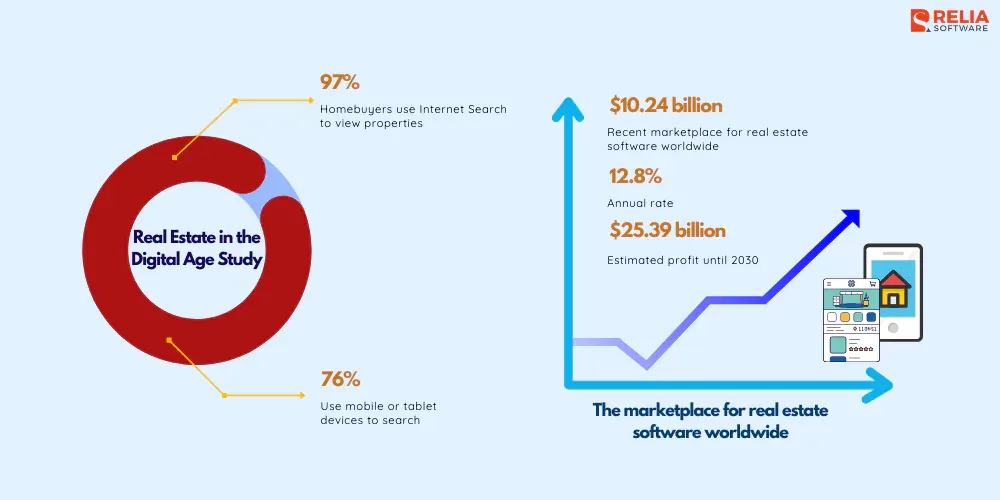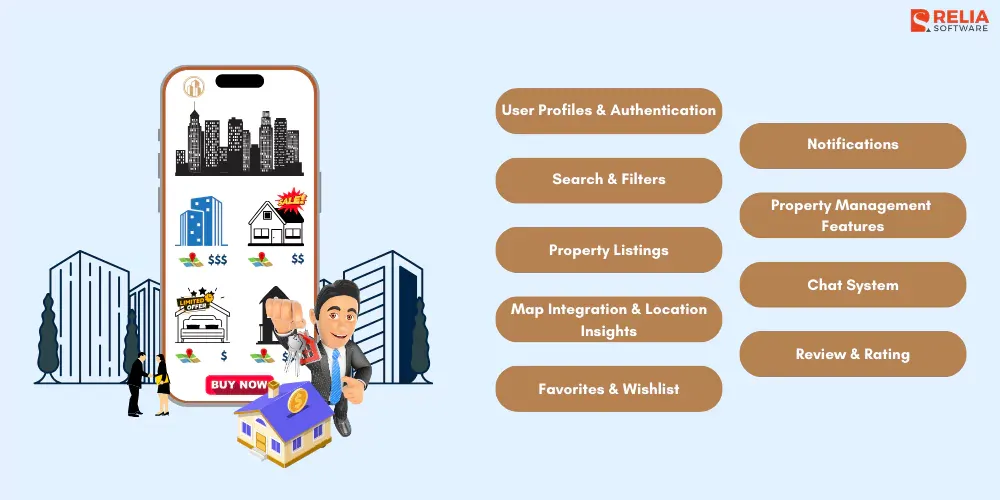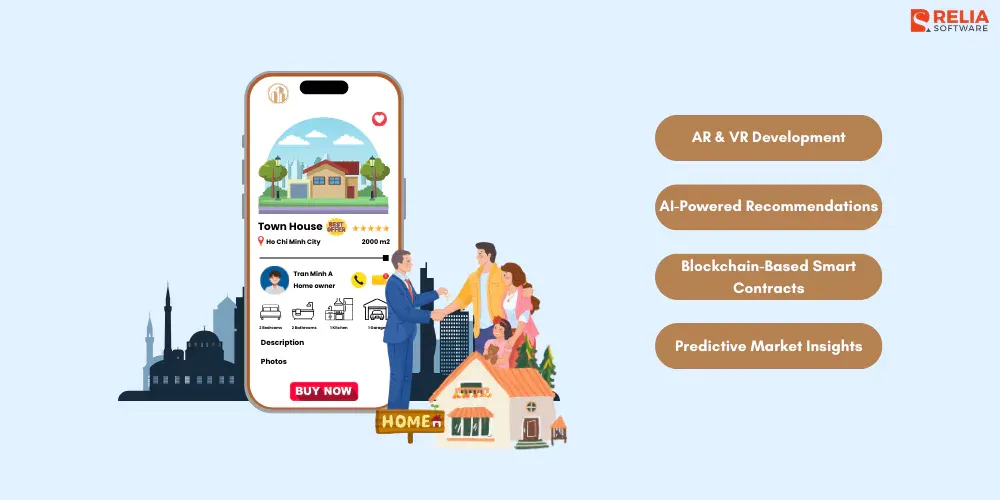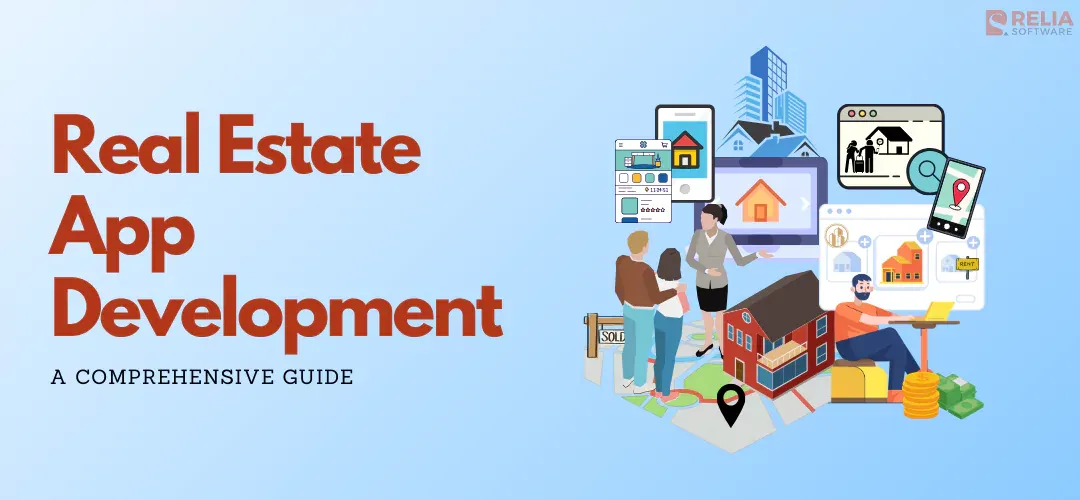Recently, the way individuals search for, buy, rent, and invest in properties is transforming. More users increasingly browse properties, chat with buyers, and manage property deals via applications. The new trend has created a need for real estate app development for businesses to get more audience and earn recurring revenue.
The key to a successful app is to know consumer needs, deliver useful functionality, and simplify use. This guide will give details about real estate app development including app types, key functionality, application development process guidelines, pricing, and industry trends.
The Market Demand for Real Estate App Development
The real estate market shifts toward digital operations leading to growing mobile application use in property transactions. A National Association of Realtors study titled Real Estate in a Digital Age discovered that 97% of homebuyers use internet searches to view properties and among them, 76% rely on mobile or tablet devices. The trend is highly driven by millennials, pointing to a high demand for mobile-friendly realty solutions.
The demand for real estate app development software is also growing at a high scale. In GrandView Research, it is estimated that the marketplace for real estate software worldwide was $10.24 billion and is to be growing at a 12.8% annual rate with $25.39 billion in 2030.
More companies in this industry are making investments in digital technologies to enable easy property management, convenient consumer engagement, and effective process transactions.
These statistics above also point to high demand for real estate app development, driven by consumer behavior and the digital revolution in business.

What is a Real Estate App?
A real estate app is a digital platform that enables users to browse, buy, sell, lease, or manage properties. Thanks to such applications, buyers do not need to access newspaper ads, in-person meetings, or phone calls to buy properties. Instead, they search properties, see prices, and interact with agents in clicks.
Each group of users will use real estate app differently:
- Buyers can browse properties, compare listings, save favorites, and receive alerts on new listings or price changes. Features like virtual tours and mortgage calculators help them make informed decisions.
- Sellers list properties with high-quality photos, track inquiries, and communicate with potential buyers. A dashboard helps manage multiple listings efficiently.
- Investors use real estate apps to analyze market trends, compare properties, track investments, and calculate ROI. Some platforms offer crowdfunding options for shared property ownership.
- Agents manage property portfolios, schedule viewings, track leads, and connect with clients. Marketing tools help increase property visibility and streamline client interactions.
Essential Features for A Real Estate App
User Profiles & Authentication
A realty application should separate profiles for sellers, brokers, and buyers so that they can receive their respective tools. Secure identification methods are phone number identification, log-in via email, and social media log-ins. These features help authenticate user details, prevent fraud, and allow verified users to list or interact with properties. These functions build trust for users to use the app.
Search & Filters
Property searches should be fast and flexible. Users can filter the system to search properties by location, price, property type, and size to find what they need quickly. Additional tools, like recently listed homes and bank-owned properties, help buyers find the right match without spending hours browsing.
Property Listings
Buyers rely on visuals to evaluate properties before visiting. The listing function should include high-quality photos, virtual tours, and detailed descriptions to give users a complete view. Detailed property listings help buyers decide if a property meets their needs.
Map Integration & Location Insights
A real estate application should include interactive maps so users can navigate properties and their surroundings in real time. Functions such as locating nearby school, hospitals, crime rates, and transportation hubs help buyers better understand the area.
Favorites & Wishlist
Many buyers explore multiple options before deciding. With a wishlist feature, buyers can bookmark their favorite properties, create shortlists, and review properties anytime without searching again. This makes buying processes smooth and enables users to track their interest properties.
Sellers and brokers can also get the insight of buyers when a property is bookmarked. When a property is bookmarked multiple times, it means there is a high demand for that property type. Based on that, sellers can adjust prices or marketing strategies accordingly.
Notifications
Push notifications remind users of important property events on time. Buyers can receive reminders of new properties, price drops, and messages from brokers or sellers without having to check constantly on the application. Reminders help users never miss key messages or appointments, leading to better response time and user engagement during the process.
Property Management Features
Real estate software for property managers and landlords needs to be able to manage lease agreements, tenant contacts, and rental listings. Features like auto collection of rent, maintenance requests, and financial reports allow automation of management, reduce manual effort, and maximize efficiency.
Chat System
Smooth communication among sellers, buyers, and agents is a key aspect of real estate deals. With a system of in-app chat, users can send inquiries, negotiate prices, discuss details of properties, and set viewings without having to leave the application. This allows for instant response time and keeps everything in one location.
Review & Rating
A review system and rating system enable users to review properties, landlords, and agents before making a decision. Both renters and buyers can leave their feedback to enable transparency and better service quality. Positive ratings provide reliability for agents and sellers, while constructive reviews let users make better-informed decisions. Positive ratings build trust for agents and sellers, and honest reviews help users make informed choices.

However, to succeed in a competitive real estate market, apps must offer more than basic search and listing features. Below are key features that give real estate apps an advantage.
AR & VR Development
In-person property viewing is time-consuming and tiring, particularly for those buyers who are viewing multiple properties before making the decision. Real estate app development based on AI VR technologies can help users take virtual tours of houses. Buyers can see room layouts, room sizes, and property features without actually visiting the property. Users can also see furniture layouts and interior changes through the AR function.
AI-Powered Recommendations
Manual searching for a suitable property takes time. AI-based recommendations personalize the browsing experience by analyzing user activity, search history, and preferences. Meanwhile, machine learning suggests properties based on price, location, and browsing patterns. It reduces searching times to find the right match.
>> Read more:
- Benefits of Artificial Intelligence (AI) in Mobile App Development
- Top 10+ Best AI Development Tools for Software Developers
Blockchain-Based Smart Contracts
Property deals involve lengthy and complex contractual, payment, and verification processes. Blockchain smart contract function can automate agreements, which ensures that transactions are made transparent and secure. Smart contracts can execute automatically if the conditions are fulfilled, with less paperwork and without intermediaries. The system reduces both property transaction duration and unexpected risks.
>> Read more:
- What is Blockchain Technology? Blockchain Fundamentals Explained
- Advantages and Disadvantages of Blockchain Technology
Predictive Market Insights
Investors and potential buyers are able to make decisions based on market trends. AI-driven predictive analytics study previous price trends, community growth, and demand for rentals to predict the future values of properties. Users are provided with information like this in order to know when to invest, buy, or sell, reducing cost risks while optimizing returns.

5 Different Types of Real Estate Apps
Property Search & Listing Apps
These apps help find homes and apartments for users through in-depth home listings, filtering, and interactive maps. Consumers filter homes based on price, neighborhood, and size, while sellers list homes with detailed descriptions and photographs. Map functionality is also essential in this app to display areas, and other details such as school rates and crime statistics to help in making decisions.
Real Estate Investment Apps
Investment apps provide investors with financial analysis, property valuation tools, and market analysis to make investment decisions. In these apps, investors get to see properties, watch their portfolios, and determine profitability using ROI calculators and market analysis functions. There also are crowdfund functions in some apps that allow investors to get access to the property market using smaller capital.
Property Management Apps
These programs assist property managers and landlords in automating rental procedures. They make it easier for rent payments through online payment, maintenance request tracking, and communication with tenants functions. Some programs even have financial report capabilities, which allow property owners to handle several properties more efficiently.
Mortgage & Loan Calculator Apps
Finance is a crucial aspect of home buying, and mortgage calculator apps. It enables users to pre-calculate loan terms, interest rates, and monthly payments. Buyers can compare multiple mortgage products, track pre-approval status, and budget using interactive financial tools.
Commercial Real Estate & Brokerage Apps
Firms can find their ideal properties such as office spaces, warehouses, or retail locations by using real estate apps. Through these platforms, users gain access to market analytics, financing tools, and direct broker communication for finding the right commercial deals. Users access available properties, analyze rental data, and finalize agreements through in-app messaging.
The Development Process for a Real Estate App
Step 1: Market Research
Before starting to develop a real estate app, understanding the market is essential. Identifying your target audience and their expectations helps create valuable features. For example, buyers look for advanced search tools and virtual tours, while renters need rent payment and maintenance request options. Besides, analyzing competitors also helps you spot market trends and refine your app strategy.
Step 2: UI/UX Design & Wireframing
A real estate app should be easy to use with an attractive interface. Easy navigation, brief details about properties, and simple filter functions let users quickly find what they are looking for.
High-quality photos, 3D virtual tours, and structured listings enhance the user experience. Meanwhile, wireframing outlines the structure of the app before the development stage, minimizing bugs and making the design more user-friendly.
Step 3: Backend & Frontend Development
The development process includes choosing a suitable tech stack to provide you a seamless performance. For instance, React Native, Swift, and Kotlin are popular for mobile app development whereas Node.js and Firebase are used for backend processes. Furthermore, the application also needs to be scalable so that additional users can interact with the app without decreasing the speed.
Real-time data syncing is crucial for keeping property listings updated. Through the use of map APIs, payment gateways, and property databases, users are provided with accurate property information, which adds to the app's usability and reliability.
>> Read more:
- Top Back-End Technologies & Trends For Developers in 2025
- 12 Frontend Technologies and 8 Development Trends in 2025
Step 4: Testing & Quality Assurance
Before launch, the app must go through the testing process to ensure a smooth user experience. For instance, UI/UX testing checks for usability issues, while security tests help protect user data. Payment processing also must be tested to prevent failed transactions, and load testing ensures the app runs efficiently under heavy traffic. Fixing issues at this stage helps prevent costly updates later.
>> Read more:
- 4 Levels Of Testing In Software Testing
- Detailed Explanation of 7 Software Testing Principles
Step 5: Deployment Strategy & Marketing
Once the app is finalized, it can be launched on App Store and Google Play. A strong marketing strategy is needed to attract users. SEO optimization improves visibility, while paid ads and social media promotions expand reach. Partnering with influencers and industry experts can build trust and increase downloads. After launch, user feedback should be collected to make continuous updates and improvements, ensuring the app remains competitive in the market.
>> Read more:
- A Comprehensive Guide To On-Premise Deployment For Businesses
- Cloud vs On-premise Deployment: The Detail Comparison
- Top 9 Best DevOps Deployment Tools for Businesses
How Do Real Estate Apps Make Money?
Your real estate application can create income through various business models that relate to your target audience, features, and goals. Selecting the optimal approach will lead to both enduring profit and a valuable application for users.
Listing Fees
Charging agents, homeowners, or property managers to list properties is the direct way of earning money. Standard listings can be free, while premium paid listings offer better visibility, high-quality images, and promotional tools. This model works well for property search apps, where more exposure helps sellers attract buyers.
Subscription Model
This model offers extra features through a paid subscription. For instance, real estate agents can subscribe to CRM integrations, analytics dashboards, and AI property suggestions. Investors can subscribe to premium market research, past data, and ROI forecasters. Subscription models provide recurring revenue, particularly for applications with specialized audiences.
Ad Revenue
Third-party advertising enables the application to generate revenue without directly charging the users. Real estate businesses like mortgage providers, relocation services, and home repair companies pay for the ad space on these apps. Some options include display advertisements, sponsored search, and banner advertisements that offer non-intrusive monetization while keeping the application free for users.
Transaction Commission
Certain apps charge a commission on successful property deals. These may be rental contracts, sales of houses, or investment transactions completed via the app. The users receive secure payment processing and escrow services, and the app gets paid for brokering the deals. This suits high-value real estate apps dealing with direct transactions.
Lead Generation for Agents
Most real estate agents depend on high-quality leads to acquire clients. The app can generate revenue by selling verified leads of buyers and sellers collected through lead generation forms. Features like inquiry tracking, profile verification, and direct messaging help connect serious clients with agents, benefiting both users and the platform.
Real Estate App Development Cost
The cost to create a real estate app varies in features, platform, integrations, and level of design. Below is an approximate calculation based on the kind of application and functionality.
App Type | Development Cost | UI/UX Design Cost | API & Integrations | Maintenance Cost (Annual) | Total |
Basic App | $25,000 - $50,000 | $5,000 - $15,000 | $5,000 - $10,000 | $5,000 - $15,000 | $40,000 - $100,000 |
Feature-Rich App | $50,000 - $120,000 | $15,000 - $30,000 | $15,000 - $40,000 | $15,000 - $35,000 | $100,000 - $250,000 |
AI-Integrated App | $120,000 - $200,000 | $30,000 - $60,000 | $40,000 - $100,000 | $30,000 - $80,000 | $250,000+ |
Basic App Development: Companies starting with a minimal viable product (MVP) can utilize this option because it provides essential characteristics such as property listings, search filters, user profiles, and contact forms.
Feature-Rich App: Adds virtual tours, mortgage calculators, in-app messaging, and advanced search filters while supporting agent-client interactions and real-time property updates.
High-End AI-Integrated App: Serves enterprise real estate and investment enterprises with AI, predictive market data, AR home staging, blockchain smart contracts, and voice search.
Additional Cost Considerations
Cost Component | Estimated Cost |
Third-Party API Integrations | $5,000 - $50,000 |
Security & Compliance | $10,000 - $30,000 |
Cloud Hosting & Server Costs | $5,000 - $20,000 (annually) |
Marketing & Launch | $10,000 - $100,000 |
Challenges in Real Estate App Development & Solutions
Data Accuracy & Updates
A real estate app must provide accurate and real-time property listings to maintain user trust. Buyers expect up-to-date availability, pricing, and property details, but managing frequent updates across multiple sources can be difficult. Outdated listings frustrate users and damage the app’s credibility.
Solutions:
- Integrate with Multiple Listing Services (MLS) and real estate databases for automatic updates.
- Use APIs to fetch real-time property data, preventing outdated information.
- Conduct regular database audits to verify details and remove inactive listings.
Security & Fraud Prevention
Real estate software deals with personal and financial information, which makes them a target for fraud. Unreal property listings, identity theft, and fake transactions are common dangers. Inadequate security measures result in scams, loss of reputation, and legal issues.
Solutions:
- Activate two-factor authentication (2FA) to prevent unauthorized access.
- Use blockchain-based smart contracts to secure transactions.
- Include secure payment gateways that encrypt financial transactions.
- Conduct regular security audits to identify and fix vulnerabilities.
Scalability & Performance
Under high traffic conditions, the application needs to operate without interruptions. Slow loading, peak-time crashes, and lagging searches cause frustration for users. Huge property databases, images, and real-time updates also challenge the system.
Solutions:
- Utilize cloud infrastructure to scale with increasing user demand.
- Maximize backend performance through caching and database indexing.
- Use content delivery networks (CDNs) for quick loading of property images.
- Perform load testing to ready the site for periods of heavy traffic.
Conclusion
Real estate applications are expanding to boost user satisfaction and open new business perspectives. To achieve success in real estate app development, businesses need secure protocols and suitable payment methods from trustworthy development firms.
At Relia Software, we develop scalable real estate applications that offer secure functionality with user-friendly interfaces based on business requirements. Contact us to turn your real estate application vision into a final product.
>>> Follow and Contact Relia Software for more information!
- Mobile App Development
- development

